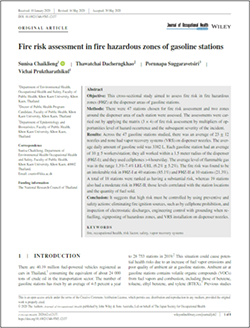#0068 Fire risk assessment in fire hazardous zones of gasoline stations

Assessing Risk of Fires at Gasoline Stations in Thailand
When you stop at a petrol station to refuel your car, have you noticed posters prohibiting the use of mobile phones and cigarettes? This prohibition is because sparks from mobile devices and cigarette smoke can combine with oxygen and fuel vapors in the air, leading to a risk of fires. Gas stations are filled with all sorts of noxious vapors, such as benzene, which not only have a negative impact station on workers’ health but also increase the risk of fire hazards. With serious consequences for human health and property, maintaining a safe and healthy environment is critical for gas station workers and customers.
To this end, we carried out the first-ever study of fire risk assessment in fire hazardous zones (FHZ) at gasoline stations in Thailand. A fire hazardous zone can be divided into two parts: FHZ-I is a 1.5-meter radius around the fuel dispenser and refuelling area, where a mixture of gases in the atmosphere alongside a real risk of fire ignition during operating hours and maintenance or flammable leakage persists for most of the year, and FHZ-II is a 1.6- to 5-meter radius of the fuel dispenser area, where the mixture of gases in the atmosphere and the risk of fire ignition is present for a short period.
We collected data from 47 stations, and found that there was an approximate 85% intolerable level of risk of fires in FHZ-I. This could be because of the presence of high concentrations of flammable gas that could ignite and explode. Only FHZ-II showed a moderate risk level at times, with 21.28% of the stations having an intolerable level of risk and 38.30 percent having a substantial risk. The main source of a fire igniting came from workers using electronic devices in FHZ-I. A significant correlation was discovered between fire risk levels in FHZ-II, the quantity of fuel sold and a station's location, with a higher health risk among workers at urban and suburban gas stations than those in the rural ones. No vapor recovery systems were installed in any of the stations.
Our study indicates a need for regular inspections and strict prohibition on mobile phones within these zones, as well as the installation of electrostatic discharge equipment and lightning conductors to alleviate fire risk.

Link to the original journal article:
https://onlinelibrary.wiley.com/doi/10.1002/1348-9585.12137
Title of the paper:
Fire risk assessment in fire hazardous zones of gasoline stations
Authors:
Sunisa Chaiklieng, Thawatchai Dacherngkhao, Pornnapa Suggaravetsiri, Vichai Pruktharathikul




